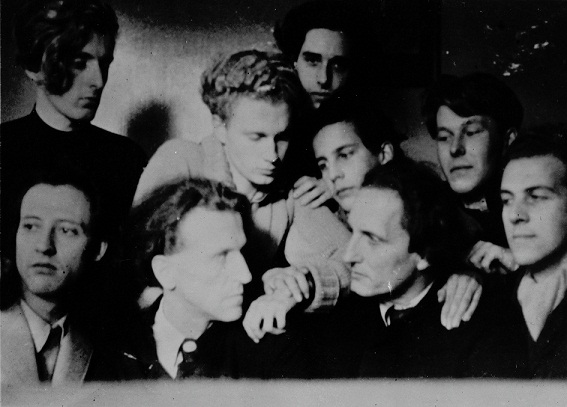Since 1997 I have been working on a book about my father, a Dutchman, and his life in a group during World War II that was part underground anti-Nazi cell and part cultish circle devoted to the homoerotic pre-war German poet Stefan George. It was based in Amsterdam, headquartered in a stately old house on the Herengracht, one of the old city’s most elegant canals, where its members distracted themselves from the chaos outside its walls by the diligent study of George’s works and the those of other great canons of European literature.
The group’s leader was a charismatic gay German writer and self-styled pedagogue named Wolfgang Frommel, who saw himself as the leader of a new Platonic academy based on the Georgean model. (The group he founded has become the "scholars and artists community" called Castrum Peregrini.) In this photo from 1944, Guido is the one on the far right, first row.)
During the War, Frommel became friends with the great German painter Max Beckmann, who had fled to Holland when his work was condemned by the Nazis as "degenerate art." Beckmann's painting, The Argonauts, was said (by Frommel) to have been inspired by a conversation he had with the artist, wherein Frommel's circle was likened to Jason's Argonauts of Greek legend.
Frommel had moved into one of the Herengracht house's apartments in 1942, bringing several critically endangered young Jewish men—his disciples—to hide there. My father, who lived upstairs with his wife, Miep, was drawn into the secret circle established and became a sort of disciple himself (“sort of”, because Guido was by nature an irrepressible iconoclast; he could never conform to rules set out by anyone, not even a man he esteemed, for awhile, above all others).
The experience melted down all the formative influences of my Guido’s past in its crucible and reshaped him into new coinage. He had run away from a school for wayward boys at the age of thirteen and taken up with Gypsy smugglers until achieving only a slightly more respectable position as young husband and bicycle delivery boy in Amsterdam ten years later. Prior to his induction into Frommel’s group, his passions had been American big band jazz and dancing.
As he put it later in describing the influence of Frommel’s group, “They opened up life for me. Before that time I was a bean in the pod and would never have sprouted, because I lived in the first stage of the absolute zero.”
The group even re-christened my father, tossing out his pedestrian nickname, George (it was too much like the name of the revered German poet) and dubbed him, “Guido”. He carried the nom de guerre henceforth.
Guido was a master carpenter, having spent years since a young boy hanging around the organ-building works of his maternal uncles, the Vermeulen clan of Weert and Alkmaar. This came in handy for hiding young Jewish refugees in Occupied Holland. He built hiding places under floor boards, above wall cabinets, and in an ancient player piano that can still be glimpsed from the street if one looks up at a certain window in the house on the Herengracht. He built an ingenious passageway from Frommel's floor to his own, via a disused elevator, that could be employed if one needed to avoid using the stairs.
Frommel's little group made it nearly through the war without mishap. The food became scarcer and scarcer, but the Dutch Resistance made sure they didn't starve entirely. They kept their spirits high with nightly readings from the canon of European literature (heavy on George, Geothe, Schiller, Hoelderlin and Dante.) The artists in their group drew with whatever materials they could scrounge. Their benefactor, the Dutch painter and stained glass artist Gisele d'Ailly, still alive and kicking at 97, supported the group through her work.
But in October 1944, the Gestapo came to the house on the Herengracht, looking for Guido. He had been betrayed by a older woman whose romantic proposals he had rejected. She had told them that there were illegals living at Guido's address. Thanks to the hiding places he had built, neither he nor one of the Jewish refugees then residing in the house were caught. (The other refugee was questioned, but, incredibly, was not arrested.)
But Guido was a marked man. He had to flee. And so, after several months of hiding out on the edges of the front lines, seeking a way across to the Allied side, he escaped across the frigid Waal (Rhine) River on January 5, 1945. The Canadian forces on the other side rescued him as he lay nearly lifeless on the southern shore, having made it across. He ended up being drafted into the Dutch Marines and sent to their military base -- in Camp Le Jeune, North Carolina, USA. Which is how Guido came to America.
But that's another story.

No comments:
Post a Comment